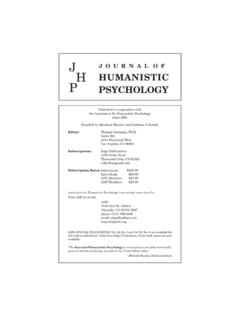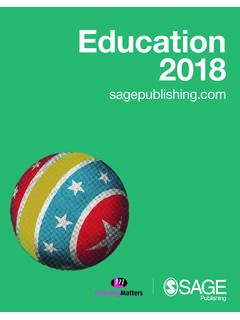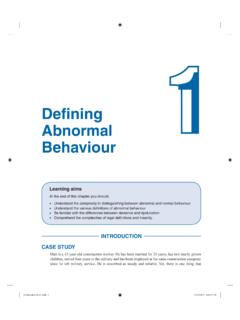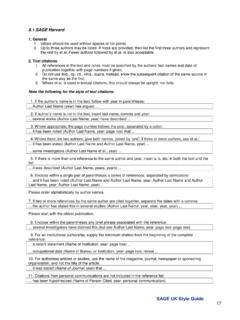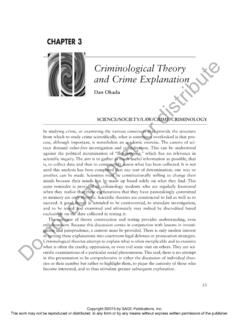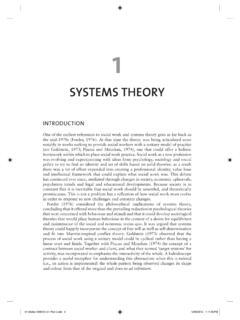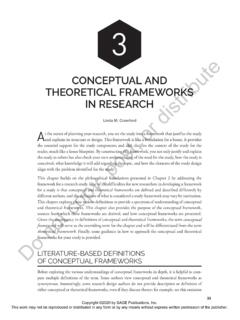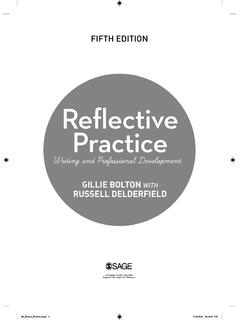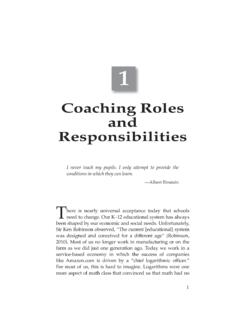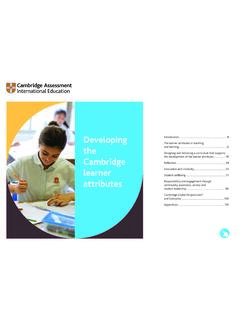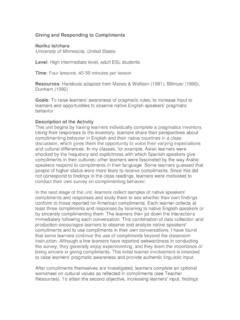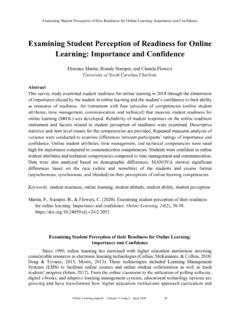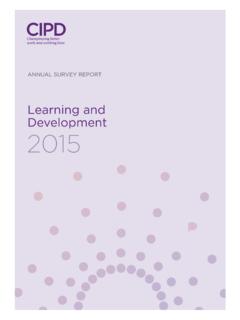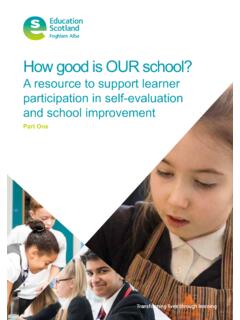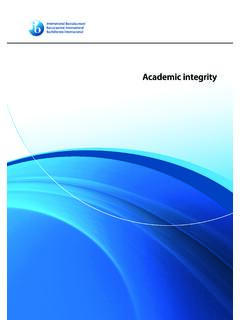Transcription of Mathematics in the Primary Curriculum - SAGE Publications Ltd
1 122 Mathematics in the Primary CurriculumWhy this area of learning is important: Mathematics introduces children to concepts, skills and thinking strategies that are essential in everyday life and support learning across the Curriculum . It helps children make sense of the numbers, patterns and shapes they see in the world around them, offers ways of handling data in an increasingly digital world and makes a crucial contribution to their development as successful learners . Children delight in using Mathematics to solve a problem, especially when it leads them to an unexpected discovery or new connections. As their confidence grows, they look for patterns, use logical reasoning, suggest solutions and try out differ-ent approaches to problems. Mathematics offers children a powerful way of communicating. They learn to explore and explain their ideas using symbols, diagrams and spoken and written language. They start to discover how Mathematics has developed over time and contributes to our economy, soci-ety and culture.
2 Studying Mathematics stimulates curiosity, fosters creativity and equips children with the skills they need in life beyond school. In this chapter there are explanations of the different kinds of reason for teaching Mathematics in the Primary school; the contribution of Mathematics to everyday life and society; the contribution of Mathematics to other areas of the Curriculum ; the contribution of Mathematics to the learner s intellectual development; the importance of Mathematics in promoting enjoyment of learning; how Mathematics is important as a distinctive form of knowledge; how the essential content of the Primary Curriculum in England is not just about knowledge and skills but also about using and applying Mathematics ;Uncorrected proof - for lecturer review only Mathematics in the Primary Curriculum 13 the various components of using and applying Mathematics in the Primary Curriculum in England; and the relationship of numeracy to mathematical teach Mathematics in the Primary school?
3 The statement about the importance of mathemati-cal understanding in the Primary National Curriculum programme of study quoted at the head of this chapter is packed with worthy intentions and is con-sequently rather difficult to take in as a whole. I find it helpful, therefore, to identify within this state-ment at least five different kinds of aims of teach-ing Mathematics in Primary schools. They relate to the contribution of Mathematics to: (1) everyday life and society; (2) other areas of the Curriculum ; (3) the child s intellectual development; (4) the child s enjoyment of learning and (5) the body of human knowledge. These are not completely dis-crete strands, nor are they the only way for structur-ing our thinking about why we teach this does Mathematics contribute to everyday life and society?This trand relates to what are often referred to as utilitarian aims. We teach mathemat-ics because it is useful for everyone in meeting the demands of everyday living.
4 The National Curriculum importance statement refers, for example, to introducing children to concepts, skills and thinking strategies that are useful in everyday life . Many everyday transactions and real-life problems, and most forms of employment, require confidence and competence in a range of basic mathematical skills and knowledge such as mea-surement, manipulating shapes, organizing space, handling money, recording and inter-preting numerical and graphical data, and using information and communications technology (ICT).Teachers themselves, for example, need a large range of such skills in their everyday professional life for example, in handling school finances and budgets, in organizing In shaping, monitoring and evaluating their medium-term planning, teachers should ensure that sufficient prominence is given to each of the five reasons for teaching Mathematics : 1. its importance in everyday life and society; 2. its importance in other Curriculum areas; 3.
5 Its importance in relation to the learner s intellectual development; 4. its importance in developing the child s enjoyment of learning; 5. its distinctive place in human knowledge and and TEAchING PoINTU ncorrected proof - for lecturer review only14 Mathematics Explained for Primary teacherstheir timetables, in planning the spatial arrange-ment of the classroom, in processing assessment data, in interpreting inspection reports and in using ICT in their teaching. We should note also here the reference to ways of handling data in an increasingly digital world : if in teaching mathemat-ics we are to equip young people for the demands of everyday life then our approach to the subject must reflect the availability of ICT applications such as calculators and relationship of mathematical processes to real-life contexts is demonstrated in this book par-ticularly in the process of modelling which is introduced in Chapter 5 and which forms the basis of the discussion of addition, subtraction, multiplication and division structures in Chapters 6 and does Mathematics contribute to other areas of the Curriculum ?
6 This strand relates to the application of Mathematics . We teach Mathematics because it has applications in a range of contexts, including other areas of the Curriculum . Much of Mathematics as we know it today has developed in response to practical challenges in science and technology, in the social sciences and in economics. So, as well as being a subject in its own right, with its own patterns, principles an d procedures, Mathematics is a subject that can be applied. The National Curriculum importance statement for Mathematics refers, for example, to mathematical skills that support learning across the Curriculum . The Primary -school teacher who is responsible for teaching nearly all the areas of the Curriculum is uniquely placed to take advan-tage of opportunities that arise, for example, in the context of science and technology, in the arts, in history, geography and society, to apply mathemat-ical skills and concepts purposefully in meaningful contexts and to make explicit to the children what Mathematics is being is a two-way process: these various cur-riculum areas can also provide meaningful and Learning experiences for children that reflect the contribution of Mathematics to everyday life and society could include, for example: (a) realistic and relevant financial and budgeting problems; (b) meeting people from various forms of employment and exploring how they use Mathematics in their work.
7 (c) helping teachers with some of the administrative tasks they have to do that draw on math-ematical and TEAchING PoINTL earning experiences for children that reflect the application of Mathematics to other Curriculum areas could include, for example: (a) collecting, organizing, repre-senting and interpreting data arising in science experiments or in enquiries related to historical, geographical and social understanding; (b) drawing up plans and meeting the demands for accurate meas-urement in technology and in design; (c) using mathematical concepts to stimu-late and support the exploration of pat-tern in art, dance and music, and (d) using mathematical skills in cross-curricular stud-ies such as transport or a visit to France .LEARNING and TEAchING PoINTU ncorrected proof - for lecturer review only Mathematics in the Primary Curriculum 15purposeful contexts for introducing and reinforcing mathematical concepts, skills and principles.
8 With the new Primary Curriculum in England (statutory from 2011) cross-curricular studies have once again become a feature of Primary education. So, for example, the programme of study for Mathematical Understanding refers to enhancing children s mathematical understanding through making links to other areas of learning and wider issues of interest and importance (DCSF/QCDA, 2010b, Mathematical Understanding, Programme of Study, section 3). Cross-curricular stud-ies will inevitably draw on and develop mathematical skills, for example, in organ-izing, representing and interpreting data and can be planned with particular mathematical content in does Mathematics contribute to the child s intellectual development?This strand includes what are sometimes referred to as thinking skills, but I am includ-ing here a broader range of aspects of the learner s intellectual development. We teach Mathematics because it provides opportunities for developing important intel-lectual skills in problem solving, deductive and inductive reasoning, creative thinking and communication.
9 We may note here, for example, the reference in the importance statement for Mathematics to thinking strategies , to using Mathematics to solve a problem and to use logical reasoning, suggest solutions and try out different approaches to problems these are all distinctive characteristics of a person who thinks in a mathematical way. Sometimes to solve a mathematical problem we have to reason logically and system-atically, using what is called deductive reasoning. Other times, an insight that leads to a solution may require thinking creatively, divergently and imagi-natively. So the importance statement for mathe-matics quoted at the head of this chapter rightly, if surprisingly, also claims that studying Mathematics .. fosters creativity . So Mathematics is an impor-tant context for developing effective problem-solving strategies that potentially have significance in all areas of human activity.
10 But also in learning Mathematics , children have many opportunities to look for patterns . This involves inductive reason-ing leading to the articulation of generalizations, statements of what is always the case. The process of using a number of specific instances to formu-late a general rule or principle, which can then be applied in other instances, is at the heart of math-ematical experiences for children in Mathematics should include a focus on the child s intellectual development, by providing opportunities to foster: (a) problem-solving strategies; (b) deductive reasoning, which includes reasoning logi-cally and systematically; (c) creative think-ing, which is characterized by divergent and imaginative thinking; (d) inductive reasoning that leads to the articulation of patterns and generalizations, and (e) communication of mathematical ideas orally and in writing, using both formal and informal language, and in diagrams and and TEAchING PoINTU ncorrected proof - for lecturer review only16 Mathematics Explained for Primary teachersThen finally, in this section, in terms of intellectual development we should note that in learning Mathematics children are developing a powerful way of communicat-ing.
